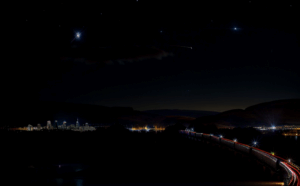Residents across Perth and Kinross, and the broader Tayside and Fife regions, have been treated to a captivating display in the night sky recently, as a train of advanced satellites, part of a global internet initiative, passed overhead. This striking celestial procession, characterized by a distinct line of bright, moving lights, captivated onlookers, prompting both wonder and curiosity.
The luminous chain of objects observed from areas including Perth itself, as well as Bridge of Earn and Tayport, were confirmed to be Starlink satellites. These are a key component of a vast constellation designed and launched by a prominent aerospace company, aiming to provide high-speed internet access globally. Understanding the Phenomenon
The satellites became visible following a recent deployment of 28 units from a space launch facility in Florida. Their appearance as a coherent, luminous string is typical shortly after launch, before they disperse into their designated orbits. For keen observers in Perthshire, this meant a unique viewing opportunity. Stargazers noted their presence particularly in the southern and north-eastern quadrants of the sky during late evening hours, with visibility periods lasting approximately four minutes over several consecutive nights.
A notable local astronomical expert shed light on the sightings. A former astronomer with the renowned Mills Observatory, explained that the distinctive ‘broken and irregular track’ observed by locals was a tell-tale sign of Starlink satellites. This characteristic sets them apart from natural celestial events, such as meteor showers like the Perseids, which would typically present as a continuous streak of light. This expert further elaborated that the visibility of these satellites is highly dependent on various factors, including their precise orbital position, the local ambient light conditions, and whether they are above the horizon during the optimal viewing times after sunset or before sunrise. Local Perspectives on the Night Sky
The unusual sight sparked widespread interest among the local community, with many taking to social media to share their photographs and reactions. From the tranquil shores near Leven beach to the more inland vantage points of Arbirlot near Arbroath and the urban backdrop of Tayport, and directly over Perth, numerous individuals managed to capture stunning images of the satellite train. One particularly endearing anecdote shared by a local from Leven beach recounted how she playfully told her daughter the lights were part of a ‘Santa Claus training exercise,’ adding a touch of childhood magic to the scientific spectacle.
Another image, captured over Perth by a keen local observer, highlighted the satellites’ clear visibility even from more populated areas. These community observations underscore a deep-seated public fascination with space and the ever-evolving advancements in satellite technology. The Broader Context of Satellite Constellations
While the recent sightings offer a moment of wonder, they also underscore the increasing number of objects in Earth’s orbit. Satellite constellations like Starlink are designed to revolutionize global connectivity, particularly in remote or underserved areas. However, their growing presence raises important discussions among the scientific community and amateur astronomers regarding potential impacts on astronomical observations and light pollution of the night sky. For residents in Perth and Kinross who cherish dark skies for stargazing, this phenomenon presents a double-edged sword: a marvel of human ingenuity that also subtly alters the natural celestial canvas.
As these satellites continue to integrate into their operational orbits, their visual prominence will diminish over time. Nevertheless, for a few nights, the skies above Perthshire offered a unique window into the future of global communication, visible from our very doorsteps. It serves as a reminder of humanity’s ongoing quest to explore and connect, with direct implications for both our daily lives and our view of the cosmos.
The luminous chain of objects observed from areas including Perth itself, as well as Bridge of Earn and Tayport, were confirmed to be Starlink satellites. These are a key component of a vast constellation designed and launched by a prominent aerospace company, aiming to provide high-speed internet access globally. Understanding the Phenomenon
The satellites became visible following a recent deployment of 28 units from a space launch facility in Florida. Their appearance as a coherent, luminous string is typical shortly after launch, before they disperse into their designated orbits. For keen observers in Perthshire, this meant a unique viewing opportunity. Stargazers noted their presence particularly in the southern and north-eastern quadrants of the sky during late evening hours, with visibility periods lasting approximately four minutes over several consecutive nights.
A notable local astronomical expert shed light on the sightings. A former astronomer with the renowned Mills Observatory, explained that the distinctive ‘broken and irregular track’ observed by locals was a tell-tale sign of Starlink satellites. This characteristic sets them apart from natural celestial events, such as meteor showers like the Perseids, which would typically present as a continuous streak of light. This expert further elaborated that the visibility of these satellites is highly dependent on various factors, including their precise orbital position, the local ambient light conditions, and whether they are above the horizon during the optimal viewing times after sunset or before sunrise. Local Perspectives on the Night Sky
The unusual sight sparked widespread interest among the local community, with many taking to social media to share their photographs and reactions. From the tranquil shores near Leven beach to the more inland vantage points of Arbirlot near Arbroath and the urban backdrop of Tayport, and directly over Perth, numerous individuals managed to capture stunning images of the satellite train. One particularly endearing anecdote shared by a local from Leven beach recounted how she playfully told her daughter the lights were part of a ‘Santa Claus training exercise,’ adding a touch of childhood magic to the scientific spectacle.
Another image, captured over Perth by a keen local observer, highlighted the satellites’ clear visibility even from more populated areas. These community observations underscore a deep-seated public fascination with space and the ever-evolving advancements in satellite technology. The Broader Context of Satellite Constellations
While the recent sightings offer a moment of wonder, they also underscore the increasing number of objects in Earth’s orbit. Satellite constellations like Starlink are designed to revolutionize global connectivity, particularly in remote or underserved areas. However, their growing presence raises important discussions among the scientific community and amateur astronomers regarding potential impacts on astronomical observations and light pollution of the night sky. For residents in Perth and Kinross who cherish dark skies for stargazing, this phenomenon presents a double-edged sword: a marvel of human ingenuity that also subtly alters the natural celestial canvas.
As these satellites continue to integrate into their operational orbits, their visual prominence will diminish over time. Nevertheless, for a few nights, the skies above Perthshire offered a unique window into the future of global communication, visible from our very doorsteps. It serves as a reminder of humanity’s ongoing quest to explore and connect, with direct implications for both our daily lives and our view of the cosmos.


